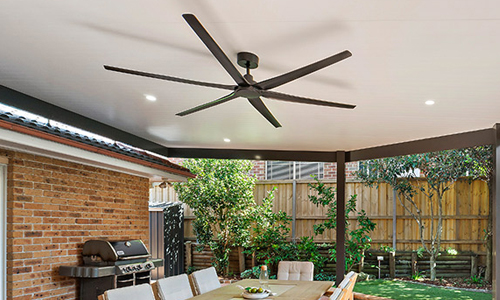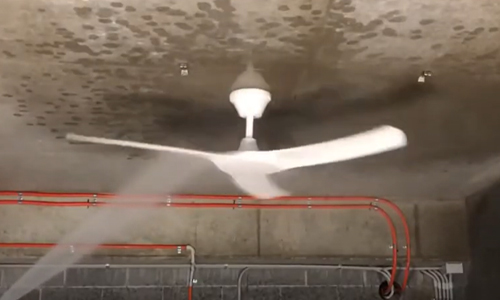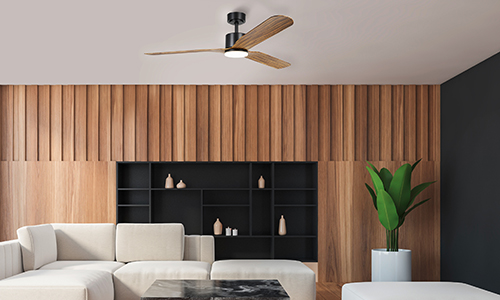Turn! Turn! Turn! Choosing the Right Ceiling Fan
Turn! Turn! Turn! Choosing the Right Ceiling Fan.
At The Fan & Light Shop we have a dedicated team of industry experts who can help and advise you as to which ceiling fan is best for the size and space you are installing in.
We can help you choose the right ceiling fan to keep you cool in summer, and we can also advise which are best suited to also keep you warmer in winter by redistributing warm air that gathers at the ceiling, pushing it down and circulating it through your room.
The right ceiling fan needs to be a suitable combination of function and aesthetics. It should provide energy efficiency but should also look balanced and proportioned to the size of your room or space.
The amount of airflow produced by a ceiling fan will also depend on where it is installed and the ability of the individual model to draw air into its sweep area. This is based primarily on the blade shape and the strength of the motor. To ensure a fan is installed clear of pitched ceilings, any other obstructions and at the optimum height, we recommend the use of extension down rods or a raked ceiling angle kit to get the maximum benefits of airflow.
Using extension down rods to lower the fan (if you have higher ceilings these also help to avoid crowding the fan with 'dead air' spaces above and beside it.)
Bear in mind that there are minimum legal requirements, and for safety reasons, the blades should be at least 2.1 metres above the ground.
Always use a licensed electrician to install your fan and make any necessary cuts to an extension down rod.
Here are a few more tips to help with choosing the right size for your home or business.
A top tip is to consider purchasing a larger fan which will achieve the same airflow on a lower speed as a smaller fan on high speed – the key differences are noise, and how the airflow from the larger fan feels: because the blade span is generally bigger, a larger fan will distribute the air over a broader area, and at a slower speed, making the air in the room feel more gentle.
In many cases, smaller fans spin naturally faster because their blades are short and are closer to the motor. This results in a stronger directional draft directly below the fan. This is why it often helps to talk to one of our experts in-store to help make the right decision for your space and preference.
For more information about air flow and the all-important feels, read our The Air That I Feel blog.
Another consideration is installing two fans in a large room, running in tandem at a lower speed. This can also be another more energy efficient alternative to a single fan running continuously at high speed, but it can depend on the motor power of the fan you have selected.
In general, ceiling fans with plastic and timber blades run quieter while also producing good airflow and are considered safer in bedrooms and public spaces. Ceiling fans with metal blades have the power to move large quantities of air quickly and are better suited to large and outdoor areas.
Learn more about choosing the right ceiling fan in our Fan Blades: The Magic Number blog.
Consider choosing a ceiling fan with a remote control. Control wiring cannot always be fitted, and remotes offer a suitable and convenient alternative. Most of the fans we sell come with remote controls. A remote control comes in two parts: a receiver module located in the fan and the handset. Remote control fans require to be installed with an isolator switch that is easily accessible. The main reasons for this are firstly for safety, should the battery on the remote run out of power and you need to switch the fan off, having an isolator switch will allow you to safely and easily power the fan off without having to cut the power directly from the switchboard. Also, by having an isolator switch you can more easily service the fan remote such as in the event where you need to reprogram the handset to the receiver or if you are having interference from another nearby fan remote. Furthermore, it allows you to easily power down the fan if it is going to not be used for an extended period such as in a spare bedroom or a holiday home. This may not only help prolong the life of the receiver and make fan servicing easier, but also complies with Australian Standards.
The Fan Size Guide below shows the largest room sizes where a single fan can be used. As we’ve mentioned, depending on the room size and other factors, more than one fan may be required for satisfactory performance. Here are our general recommendations:
- <48” (122 cm) – smaller than 4 m × 4 m area (16 m¬2), e.g. small bedroom
- 48” (122 cm) – 4 m × 4 m area (16 m¬2), e.g. common bedroom/small office
- 52” (132 cm) – 5 m × 5 m area (25 m2), e.g. common living area
- 60” (142 cm) – 6 m × 6 m area (36 m2), e.g. common living area/outdoor
- >60” (142 cm) – larger than 6 m × 6 m area (36 m2), e.g. large living area/outdoor





